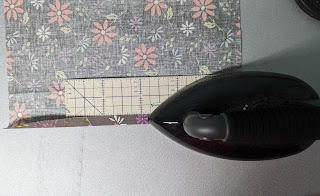Big
Scrappy Pillow
20”
x 20”
Supplies
(4) 2 ½” x 12 ½” rectangles - Border
(2) 14” x 20 ½” rectangles – Backing
Thread to match the backing fabric.
20” x 20” pillow form
Sewing
Lay (36) squares out following the layout.
Sew the center squares together into rows. Press seams following the arrows in the layout diagrams below.
Then sew the rows together. Press to one side.
Sew a 2 ½” x 12 ½” border piece to each side of the pillow center.
Sew two sets of (8)
squares together for side borders and press to one side. Add the borders to the sides of the pillow
center from the diagram above. Press toward this border.
Sew two sets of (10)
squares together for the top and bottom borders, and press to one side. Then
add the border to the top and bottom of the pillow center. Press toward
this border.
I love using the Hot Ruler from Clover (Purchase HERE). You can press on this Hot Ruler, so making the hem on the backing pieces of the pillow sooo easy! This ruler is 2 1/2" wide x 10" long.
Place your backing wrong side up on your ironing board. Then place the Hot Ruler, ruler side up, along the 20 ½" side.
On one 20 ½" side of the backing, fold the raw edge of the fabric up to the 1/2" line and press. Move the ruler to finish the whole backing piece. Repeat for the second backing piece.
Open the pressed 1/2" hemline.
Fold the raw edge to the
press line and fold it up; this will enclose the raw edge of the backing on one
side. Repeat for the second backing piece.
Now with matching thread, top stitch about 1/8" from the folded edge. Repeat for the second backing piece.
Now, lay the pillow front
on your table right side up, and place one backing piece wrong side up on top
of the left side of the pillow front. Make sure to match raw edges, placing the hem in the middle of the pillow front. Pin in place.
Next, using the second backing piece, place it on the right side of the pillow
front, wrong side up. Make sure to match raw edges, placing the hem in the
middle of the pillow front. Pin in place. *Note: the backing pieces will
overlap.
Step 7:
Once
your backing is pinned in place, from the corner, measure in 3/4" and
place a dot, then measure out 5" from the dot in both directions and mark
a dot that is 1/4" from the raw edge. Now mark a slightly curved
line from dot to dot, do this in both directions. This line will not be
straight (This will help when turning the pillow right side out, there will be
no sharp points on the corners.)
Repeat
for all 4 corners.
Stitch all the way around
the pillow with a 1/4" seam. When
you reach the lines that are drawn on the backing, stitch on the lines,
backstitching at the beginning and end to reinforce the seam at that point.
Now, to reduce the bulk
in the corners of the pillow, follow the picture to trim the corners. A
combination of both trimming and grading the corners is needed to reduce bulk
and make the corners sharp and crisp when turned right side out and
pressed. Make sure not to trim too close to the corner stitching. If you
trim too close when turning, you run the risk of pushing a hole in the corners.
Trim all 4 corners.
Turn the pillow right
side out, poking corners out. I use the OESD Expert Point & Press
Tool. There are two different sizes of round ends on this tool to use for all
kinds of turning. My tool is round because it was one of the first made. They have now made them hexagon-shaped so that the tool will not roll off your
sewing table!!
Stuff the pillow form through the opening in the back of the pillow.
*You can make your own pillow form by using (2) 20 1/2" x 20 1/2" muslin (or scrap) pieces. Sew together, leaving a 4" hole on one side. Turn the form right side out and stuff it with polyfill or batting scraps to the firmness of your liking. Hand sew the hole closed, then place the form inside the pillow.
Enjoy!!
Keep on Stitchin'
Meg
Like me on FACEBOOK






































